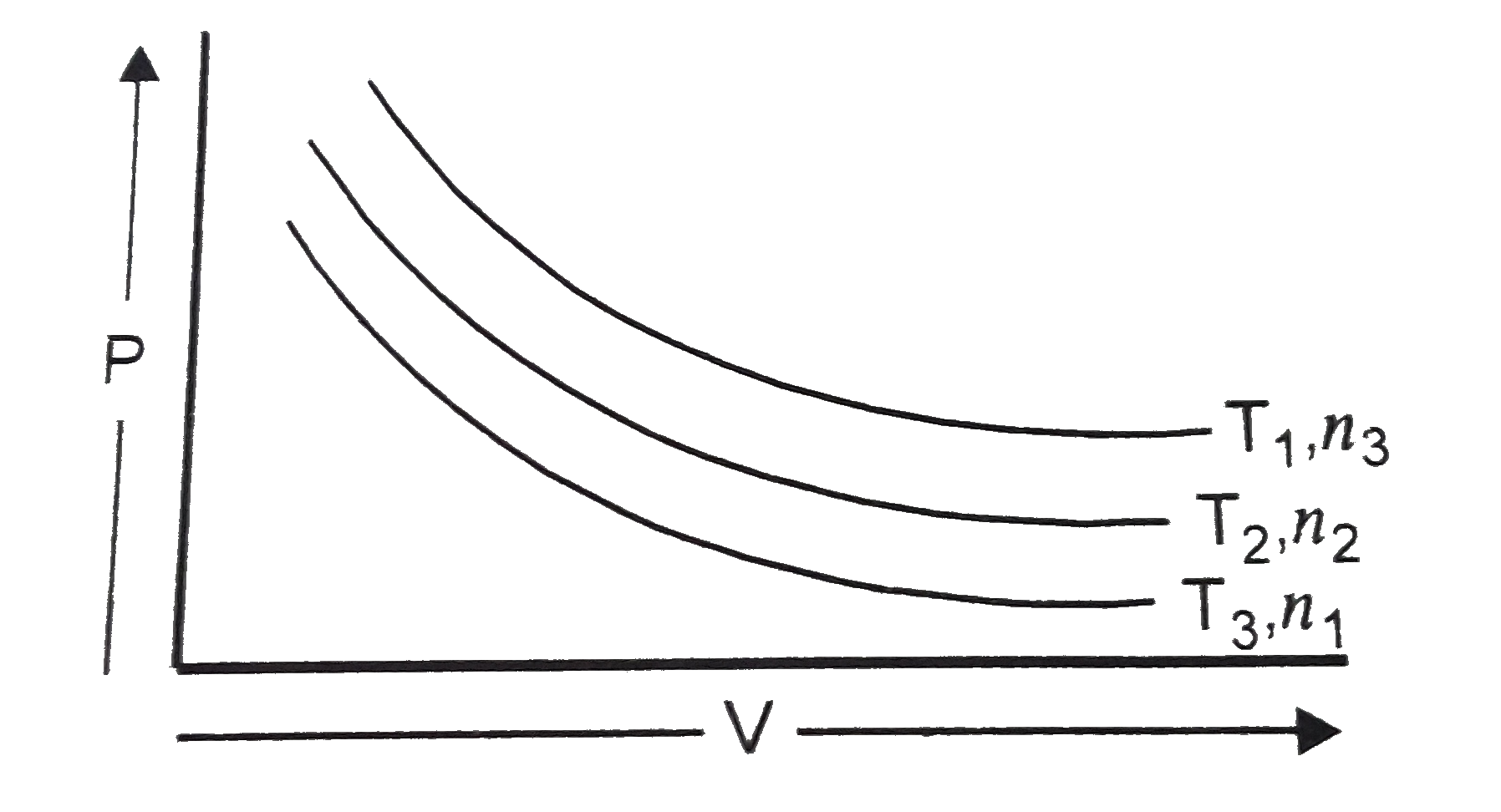Multiple Choice Question (Select the correct Answer) from S DINESH & CO CHEMISTRY (HINGLISH) STATES OF MATTER : GASES AND LIQUIDS for Class 11
| Class 11 | CHEMISTRY |
| Chapter | STATES OF MATTER : GASES AND LIQUIDS |
| S DINESH & CO CHEMISTRY (HINGLISH) | Multiple Choice Question (Select the correct Answer) |
| Medium | English |
| Academic Year | 2023-2024 |
Question 39
A teacher enters a classroom from front door while a student from back door. There are 13 equidistant rows of benches in the classroom. The teacher releases N2O, the laughing gas, from the first bench while the student releases the weeping gas (C6H11OBr) from the last bench. At which row will the students starts laughing and weeping simultaneously? View SolutionQuestion 48
Gases posses characteristic critical temperature which depends upon the magnitude of intermolecular forces between the particles. Following are the critical temperatures of some gases.
GasesH2HeO2N2Critical temperature in kelvin33.25.3154.3126
From the above data what would be the order of liquefaction of these gases ? Start writing the order from the gas liquefying firstView SolutionQuestion 64
Assertion (A) Gases do not liquefy above their critical temperature, even on applying high pressure.
Reason (R) Above critical temperature, the molecular speed is high and intermolecular attractions cannot hold the molecules together because they escape because of high speed.View SolutionQuestion 165
The coefficient of viscosity (η) of a fluid moving steadily between two surface is given by the formula (f)=ηAdV/dx where f is the frictional force on the fluid, A is the area in the fluid, and dV/dx is velocity gradient inside the fluid at that area. The SI unit of viscosity is given as :View SolutionQuestion 172
For real gases, van der Waals' equation is written as
(P+an2V2)(V−nb)=nRT
where a and b are van der Waals' constants.
Two sets of gases are:
(I)O2,CO2,H2 and He(II)CH4,O2 and O2andH2
The gases given in set I in increasing order of b and gases given in set II in decreasing order of a are arranged below. Select the correct order from the following :View SolutionQuestion 211
Two closed bulb of euqal volume (V) containing an ideal gas initially at pressure pi and Temperature T1 are connected through a narrow tube of negligible volume as shown in the figure below. The temperature of one of the bulbs is then released to T2. The final pressure pt is :
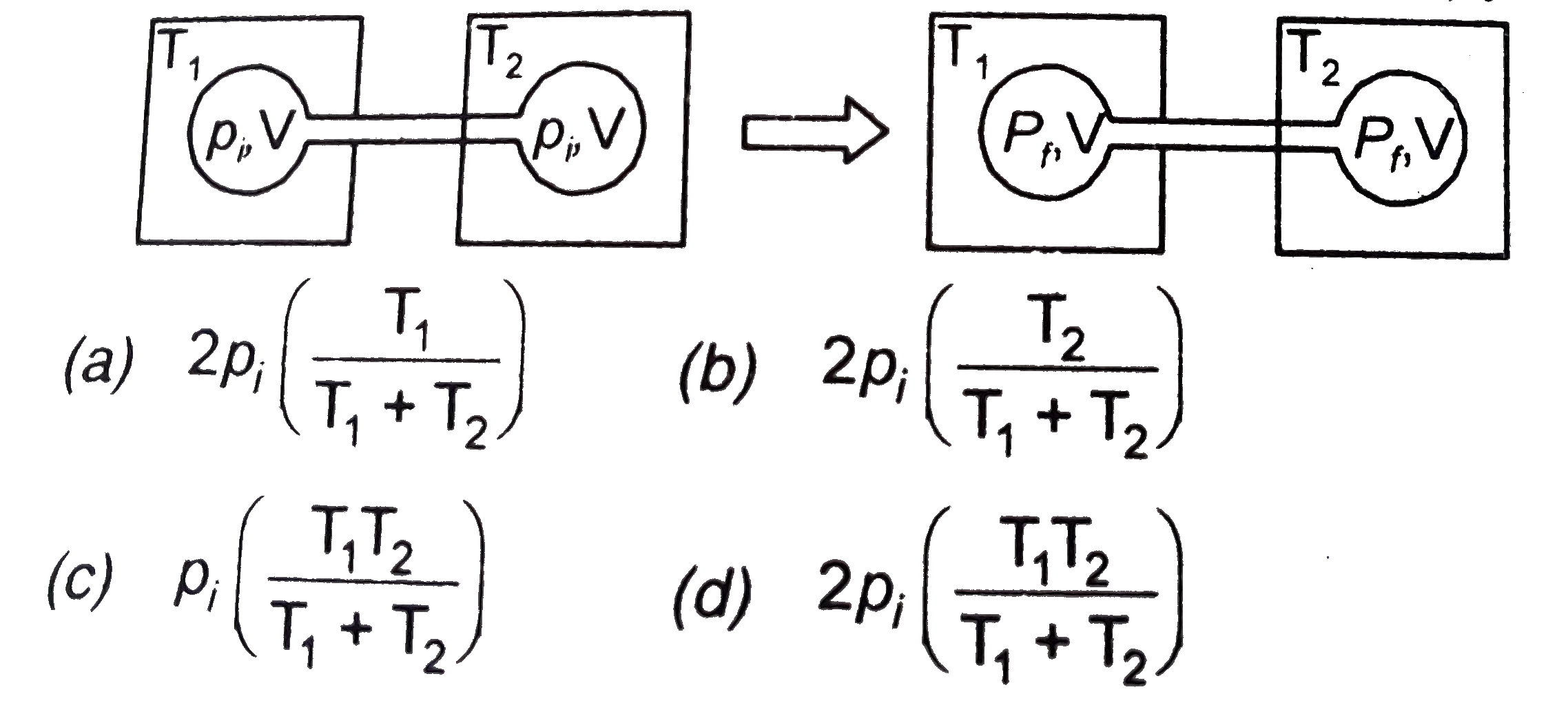 View Solution
View SolutionQuestion 213
Out of the three stes of matter, only the gases have most of the physical properties common. They neither have definite shapes nor volumes. Upon mixing they form hoogeneous mixture irespective of their nature and can also be compressed on applying pressure. In addition to these, the gases obey different gas laws such as Noyle's Law, Charles's Law, Dalton's Law of partial pressures, Graham's Law of diffusion etc. Based upon these laws, ideal gas equation PV=nRT has been derived.
When the produce of pressure and volume is plotted against pressure for a given amount of a gas, the obtained is View SolutionQuestion 214
Out of the three stes of matter, only the gases have most of the physical properties common. They neither have definite shapes nor volumes. Upon mixing they form hoogeneous mixture irespective of their nature and can also be compressed on applying pressure. In addition to these, the gases obey different gas laws such as Noyle's Law, Charles's Law, Dalton's Law of partial pressures, Graham's Law of diffusion etc. Based upon these laws, ideal gas equation PV=nRT has been derived.
4-4 g of a gas at STP occupies a volume of 2.224 L. The gas can be :View SolutionQuestion 215
Out of the three stes of matter, only the gases have most of the physical properties common. They neither have definite shapes nor volumes. Upon mixing they form hoogeneous mixture irespective of their nature and can also be compressed on applying pressure. In addition to these, the gases obey different gas laws such as Noyle's Law, Charles's Law, Dalton's Law of partial pressures, Graham's Law of diffusion etc. Based upon these laws, ideal gas equation PV=nRT has been derived.
Which pair of gaseous species diffuse through a small jet with the same rate of diffusion at same P and T ?View SolutionQuestion 216
Out of the three stes of matter, only the gases have most of the physical properties common. They neither have definite shapes nor volumes. Upon mixing they form hoogeneous mixture irespective of their nature and can also be compressed on applying pressure. In addition to these, the gases obey different gas laws such as Noyle's Law, Charles's Law, Dalton's Law of partial pressures, Graham's Law of diffusion etc. Based upon these laws, ideal gas equation PV=nRT has been derived.
For an ideal gas, number of moles per litre in terms of its pressuure P, gas constant R and temperature T is :View SolutionQuestion 217
Out of the three stes of matter, only the gases have most of the physical properties common. They neither have definite shapes nor volumes. Upon mixing they form hoogeneous mixture irespective of their nature and can also be compressed on applying pressure. In addition to these, the gases obey different gas laws such as Noyle's Law, Charles's Law, Dalton's Law of partial pressures, Graham's Law of diffusion etc. Based upon these laws, ideal gas equation PV=nRT has been derived.
Same mass of CH4 and H2 at taken in a container. The partial pressure caused by H2 is View SolutionQuestion 218
The gases obey the different gas laws only theoretically. Practically all of them show some deviation from these laws. These are called real gases. The deviation are maximum under high pressure and at low temperature. These are comparatively small when the conditions are reversed. It has been found that the easily liquefiable gases show more deviations from the ideal gas behaviour as compared to the gases which are liquified with difficulty.
Gas deviates from ideal gas behaviour because moleculesView SolutionQuestion 219
The gases obey the different gas laws only theoretically. Practically all of them show some deviation from these laws. These are called real gases. The deviation are maximum under high pressyre and at low temperature. These are comparatively small when the conditions are reversed. It has been found that the easily liquefiable gases show more deviations from the ideal gas beheviour as compared to the gases which are liqufied with diffculty.
An ideal gas is one which obeys the gas laws underView SolutionQuestion 220
The gases obey the different gas laws only theoretically. Practically all of them show some deviation from these laws. These are called real gases. The deviation are maximum under high pressyre and at low temperature. These are comparatively small when the conditions are reversed. It has been found that the easily liquefiable gases show more deviations from the ideal gas beheviour as compared to the gases which are liqufied with diffculty.
The temperature at which the real gases obey the ideal ga laws over a wide range of pressure is calledView SolutionQuestion 221
The gases obey the different gas laws only theoretically. Practically all of them show some deviation from these laws. These are called real gases. The deviation are maximum under high pressyre and at low temperature. These are comparatively small when the conditions are reversed. It has been found that the easily liquefiable gases show more deviations from the ideal gas beheviour as compared to the gases which are liqufied with diffculty.
The van der Waals equation reduces itself to ideal gas equation atView SolutionQuestion 222
The gases obey the different gas laws only theoretically. Practically all of them show some deviation from these laws. These are called real gases. The deviation are maximum under high pressyre and at low temperature. These are comparatively small when the conditions are reversed. It has been found that the easily liquefiable gases show more deviations from the ideal gas beheviour as compared to the gases which are liqufied with diffculty.
The compressibility factor for an ideal gas is :View SolutionQuestion 223
Surface tension of a liquid is a molecular phenomenon of liquids involving the force of cohension along the liquid molecules. It is scalar quantity and is numberically equal to the surface energy. Numerically, it is proved that the potential soluble salts and surfce active substance. Sparingly soluble salts and surface acitve substances decrease the surface tension of the liquid. However, the fairly soluble solutes increase the surface tension of the liquid. Surface tension of a liquid is independent of surface area but it depends on the intemolecular forces and the temperature.
Which among the following is not the unit of surface tension ?View SolutionQuestion 224
Surface tension of a liquid is a molecular phenomenon of liquids involving the force of cohesion among the liquid molecules. It is a scalar quantity and numerically equal to the surface energy. Numerically, it is proved that the potential enenergy of a liquid is maximum on the surface. Sparingly soluble salts and surface active substances decrease the surface tension of the liquid, however, the fairly soluble solute increase is independent of surface area but if depends on the intermolecular force and the temperature.
Surface tension of a liquid is zero at:View SolutionQuestion 225
Surface tension of a liquid is a molecular phenomenon of liquids involving the force of cohension along the liquid molecules. It is scalar quantity and is numberically equal to the surface energy. Numerically, it is proved that the potential soluble salts and surfce active substance. Sparingly soluble salts and surface acitve substances decrease the surface tension of the liquid. However, the fairly soluble solutes increase the surface tension of the liquid. Surface tension of a liquid is independent of surface area but it depends on the intemolecular forces and the temperature.
Surface tension of a liquid does not depend on :View SolutionQuestion 226
Surface tension of a liquid is a molecular phenomenon of liquids involving the force of cohension along the liquid molecules. It is scalar quantity and is numberically equal to the surface energy. Numerically, it is proved that the potential soluble salts and surfce active substance. Sparingly soluble salts and surface acitve substances decrease the surface tension of the liquid. However, the fairly soluble solutes increase the surface tension of the liquid. Surface tension of a liquid is independent of surface area but it depends on the intemolecular forces and the temperature.
Whenoil is placed on the surface of hot water, formation of droplets takes place because :View SolutionQuestion 227
Surface tension of a liquid is a molecular phenomenon of liquids involving the force of cohension along the liquid molecules. It is scalar quantity and is numberically equal to the surface energy. Numerically, it is proved that the potential soluble salts and surfce active substance. Sparingly soluble salts and surface acitve substances decrease the surface tension of the liquid. However, the fairly soluble solutes increase the surface tension of the liquid. Surface tension of a liquid is independent of surface area but it depends on the intemolecular forces and the temperature.
Which of the following has the highest surface tension ?View SolutionQuestion 228
X and Y are two volatile liquids with molar weights of 10gmol−1 and 40gmol−1 respectively. Two cotton plugs, one soaked in X and the other soaked in Y, are simultaneously placed at the ends of a tube of length L=24 cm, as shown in the figure.
The tube is filled with an inert gas at 1 atm pressure and a temperature of 300K. Vapours of X and Y react to form a product whichh is first observed at a distance dcm from the plug soaked in X.
Take X and Y to have equal molecular diameters and assume ideal behaviour for the inert gas and two vapours.

The value of d in cm (shown in figure), as estimated from Graham's law, is View SolutionQuestion 229
X and Y are two volatile liquids with molar weights of 10gmol−1 and 40gmol−1 respectively. Two cotton plugs, one soaked in X and the other soaked in Y, are simultaneously placed at the ends of a tube of length L=24 cm, as shown in the figure.
The tube is filled with an inert gas at 1 atm pressure and a temperature of 300K. Vapours of X and Y react to form a product whichh is first observed at a distance dcm from the plug soaked in X.
Take X and Y to have equal molecular diameters and assume ideal behaviour for the inert gas and two vapours.
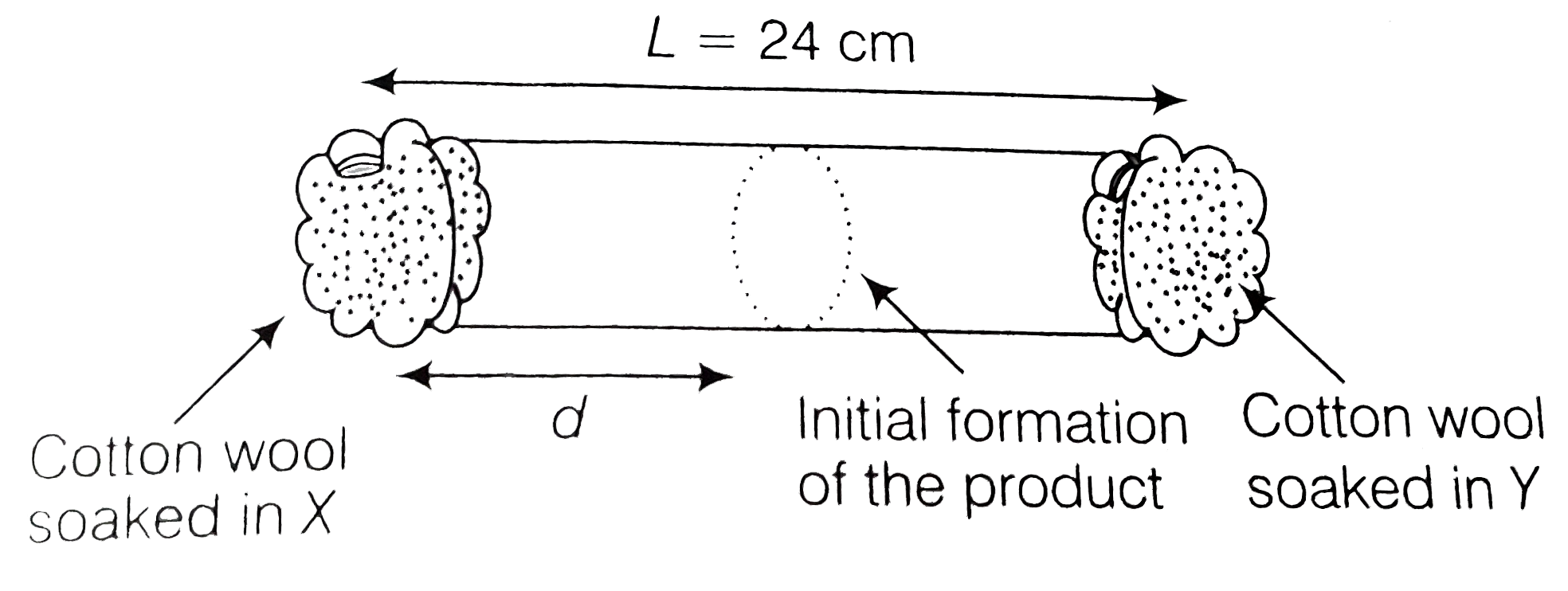
The experimental value of d is found to be smaller than the estimate obtained using Graham's law. This is due toView Solution
All Exercises from S DINESH & CO CHEMISTRY (HINGLISH) Class 11 CHEMISTRY STATES OF MATTER : GASES AND LIQUIDS
- ASSERTION AND REASON
- ASSIGNMENT (VERY SHORT ANSWER QUESTION)
- COMPHENSION 1
- COMPHENSION 2
- COMPHENSION 3
- COMPHENSION 4
- LONG ANSWER QUESTION
- MATRIX
- MULTIPLE CHOICE QUESTION
- MULTIPLE CHOICE QUESTION (SELECT THE CORRECT ANSWER)
- PRACTICE
- QUESTION BANK (MCQ)
- SELECT THE CORRECT ANSWER
- SHORT ANSWER TYPE QUESTIONS
- STATEMENT TYPE QUESTION
- STRAIGHT OBJECTIVE TYPE (MCQ)
- VERY SHORT ANSWER QUESTIONS
- ASSERTION AND REASON
- ASSIGNMENT (VERY SHORT ANSWER QUESTION)
- COMPHENSION 1
- COMPHENSION 2
- COMPHENSION 3
- COMPHENSION 4
- LONG ANSWER QUESTION
- MATRIX
- MULTIPLE CHOICE QUESTION
- MULTIPLE CHOICE QUESTION (SELECT THE CORRECT ANSWER)
- PRACTICE
- QUESTION BANK (MCQ)
- SELECT THE CORRECT ANSWER
- SHORT ANSWER TYPE QUESTIONS
- STATEMENT TYPE QUESTION
- STRAIGHT OBJECTIVE TYPE (MCQ)
- VERY SHORT ANSWER QUESTIONS
- ASSERTION AND REASON
- ASSIGNMENT (VERY SHORT ANSWER QUESTION)
- COMPHENSION 1
- COMPHENSION 2
- COMPHENSION 3
- COMPHENSION 4
- LONG ANSWER QUESTION
- MATRIX
- MULTIPLE CHOICE QUESTION
- MULTIPLE CHOICE QUESTION (SELECT THE CORRECT ANSWER)
- PRACTICE
- QUESTION BANK (MCQ)
- SELECT THE CORRECT ANSWER
- SHORT ANSWER TYPE QUESTIONS
- STATEMENT TYPE QUESTION
- STRAIGHT OBJECTIVE TYPE (MCQ)
- VERY SHORT ANSWER QUESTIONS
- ASSERTION AND REASON
- ASSIGNMENT (VERY SHORT ANSWER QUESTION)
- COMPHENSION 1
- COMPHENSION 2
- COMPHENSION 3
- COMPHENSION 4
- LONG ANSWER QUESTION
- MATRIX
- MULTIPLE CHOICE QUESTION
- MULTIPLE CHOICE QUESTION (SELECT THE CORRECT ANSWER)
- PRACTICE
- QUESTION BANK (MCQ)
- SELECT THE CORRECT ANSWER
- SHORT ANSWER TYPE QUESTIONS
- STATEMENT TYPE QUESTION
- STRAIGHT OBJECTIVE TYPE (MCQ)
- VERY SHORT ANSWER QUESTIONS
- ADDITIONAL IMPORTANT QUESTIONS
- CONCEPT BASED QUESTIONS
- EXAMPLES
- EXERCISE FULLY SOLVED
- PROBLEM
- VALUE BASED QUESTION
- ADDITIONAL IMPORTANT QUESTIONS
- CONCEPT BASED QUESTIONS
- EXAMPLES
- EXERCISE FULLY SOLVED
- PROBLEM
- VALUE BASED QUESTION
- ADDITIONAL IMPORTANT QUESTIONS
- CONCEPT BASED QUESTIONS
- EXAMPLES
- EXERCISE FULLY SOLVED
- PROBLEM
- VALUE BASED QUESTION
- ADDITIONAL IMPORTANT QUESTIONS
- CONCEPT BASED QUESTIONS
- EXAMPLES
- EXERCISE FULLY SOLVED
- PROBLEM
- VALUE BASED QUESTION
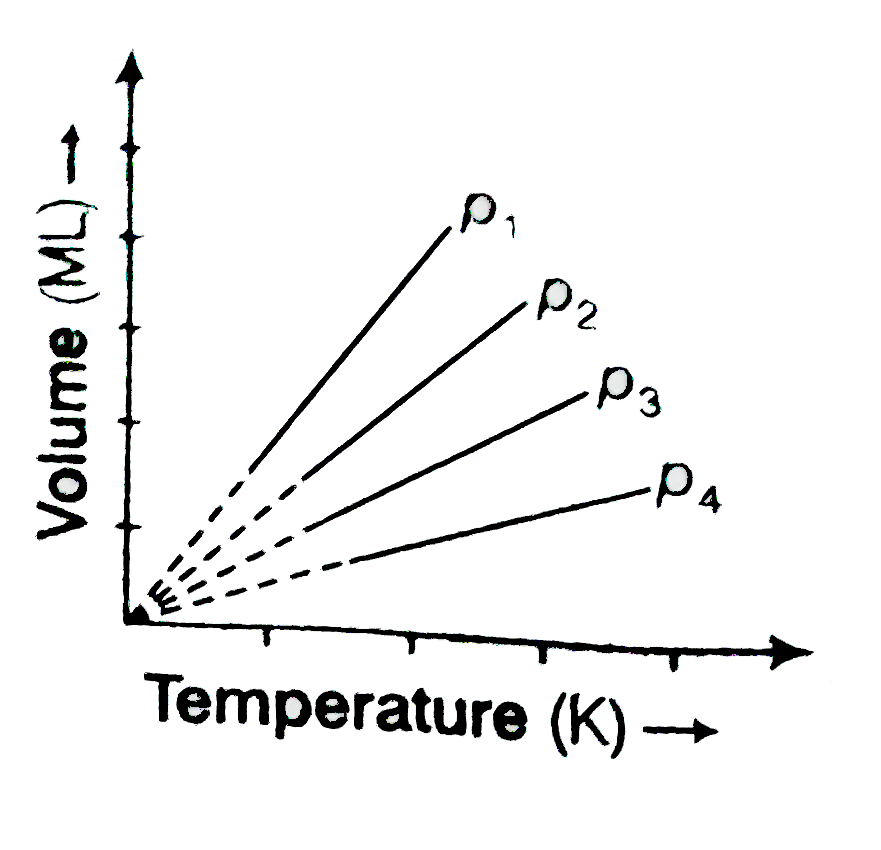
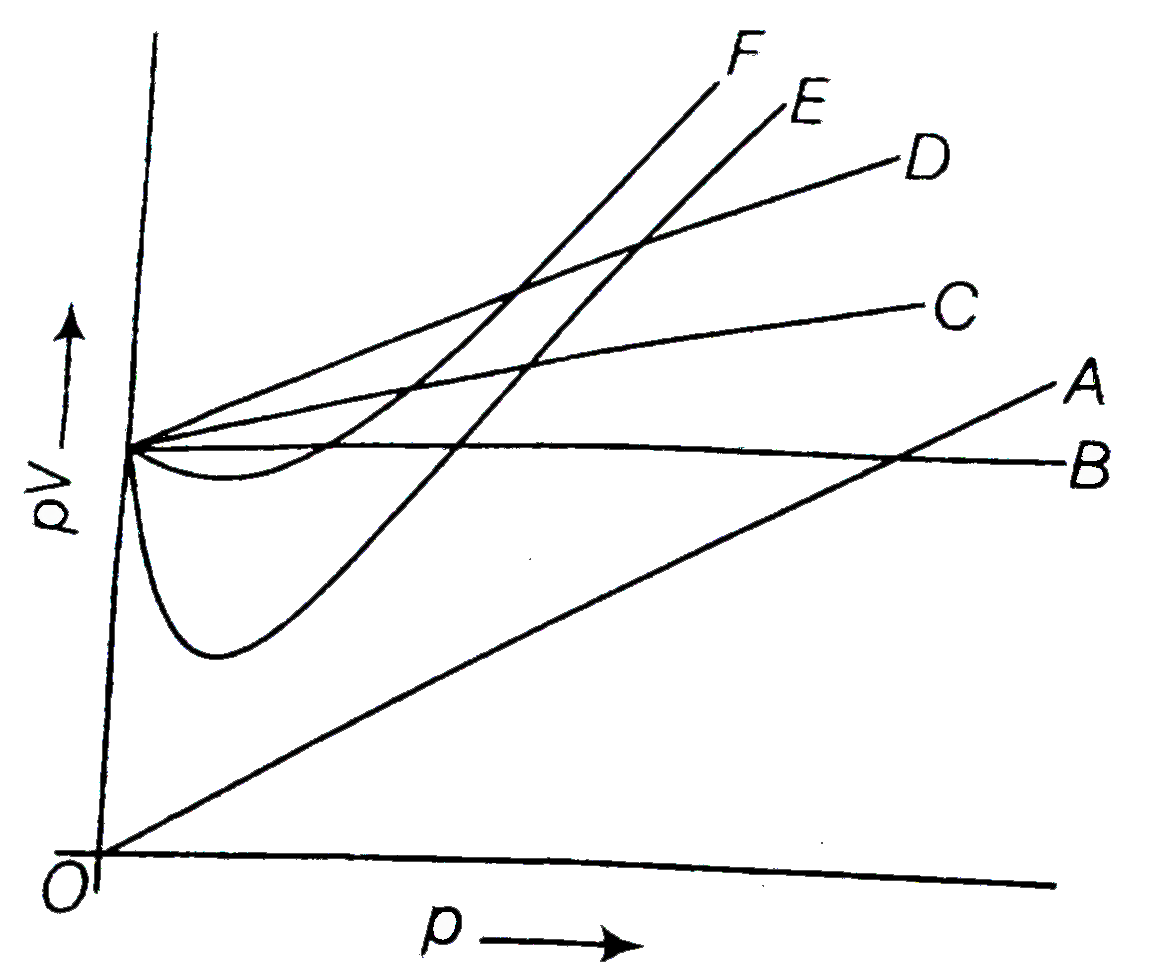
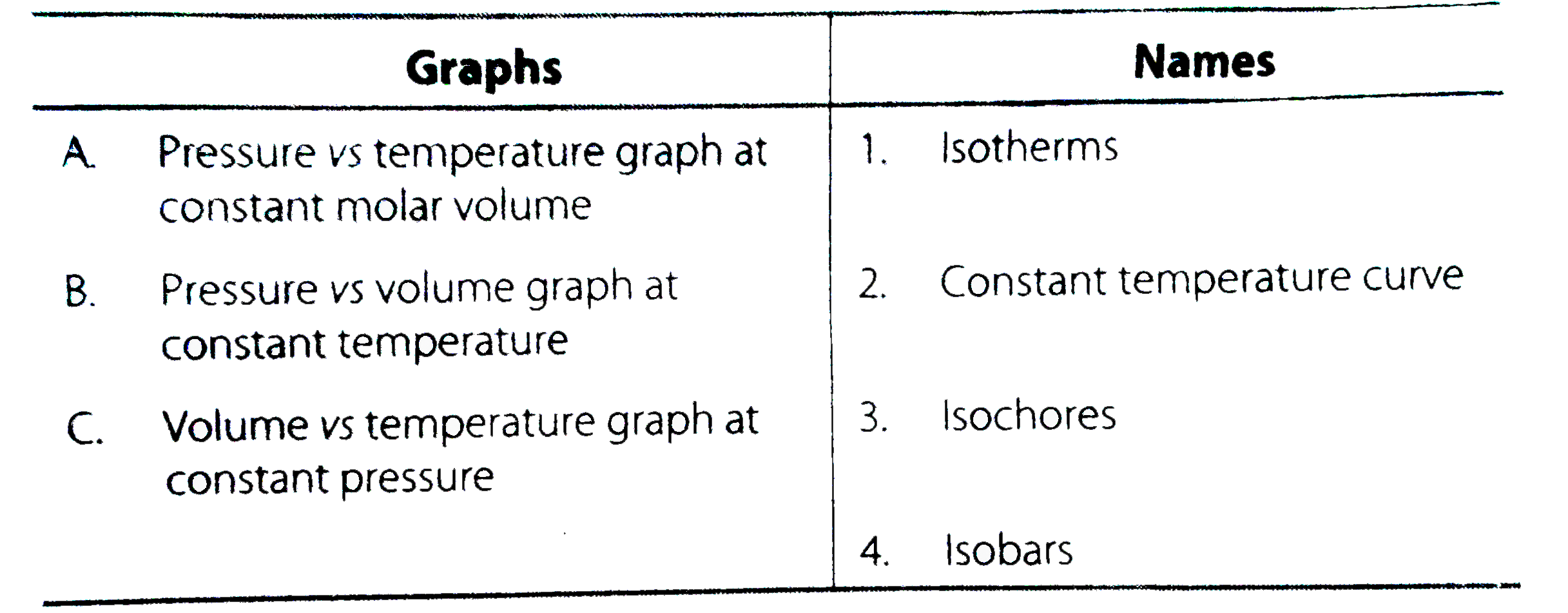
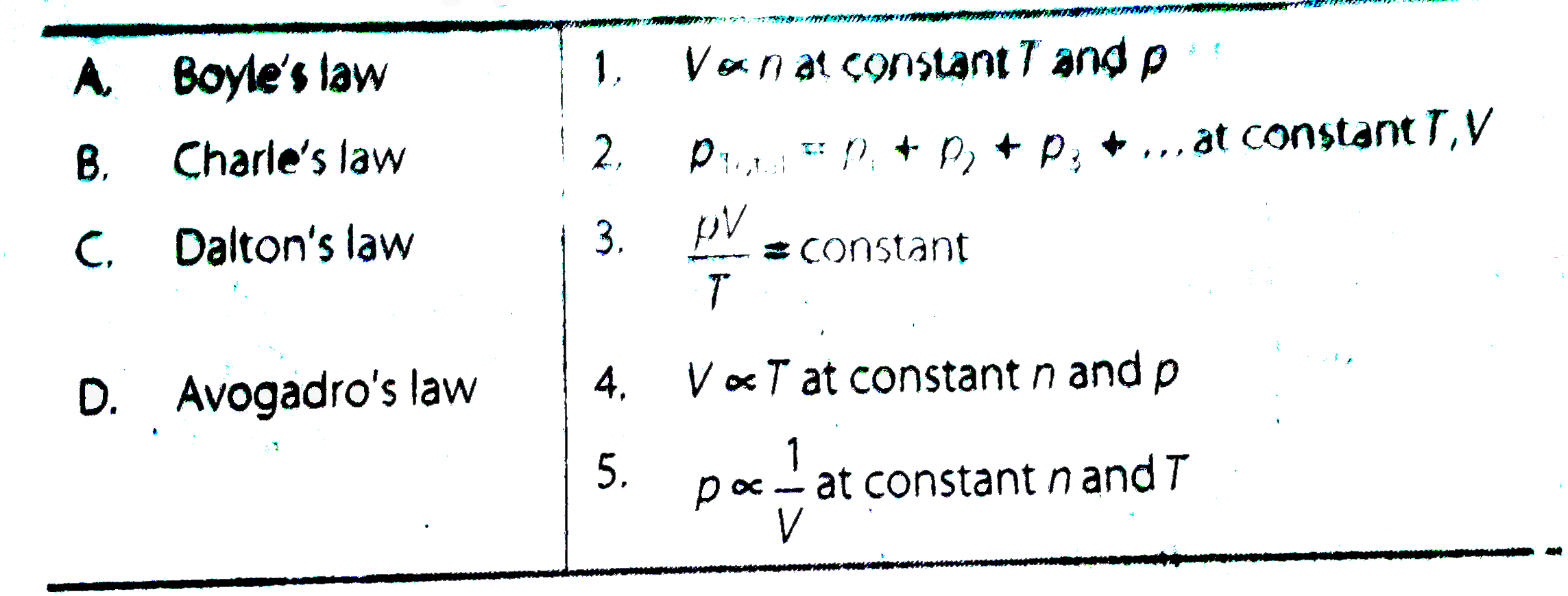
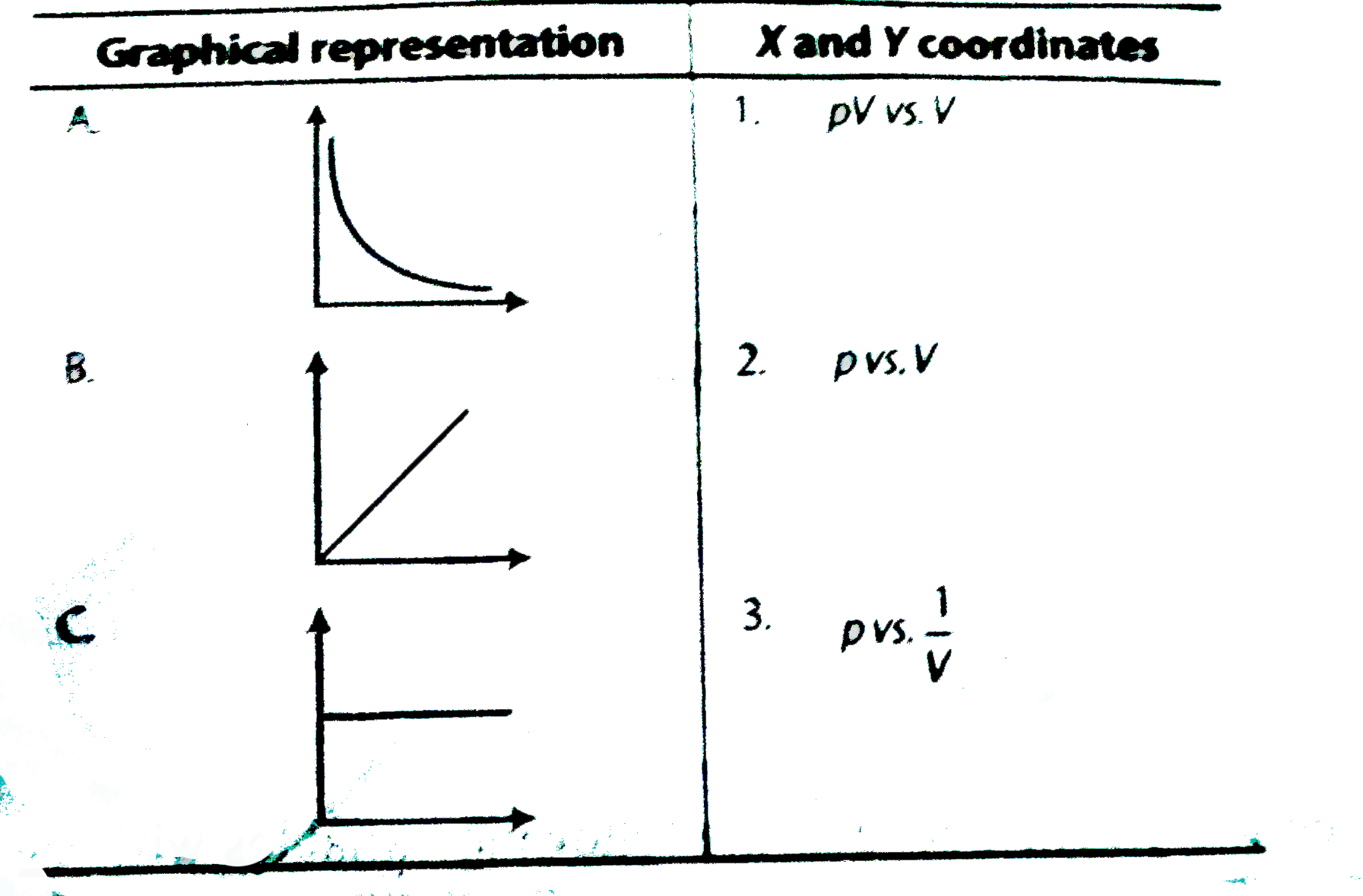
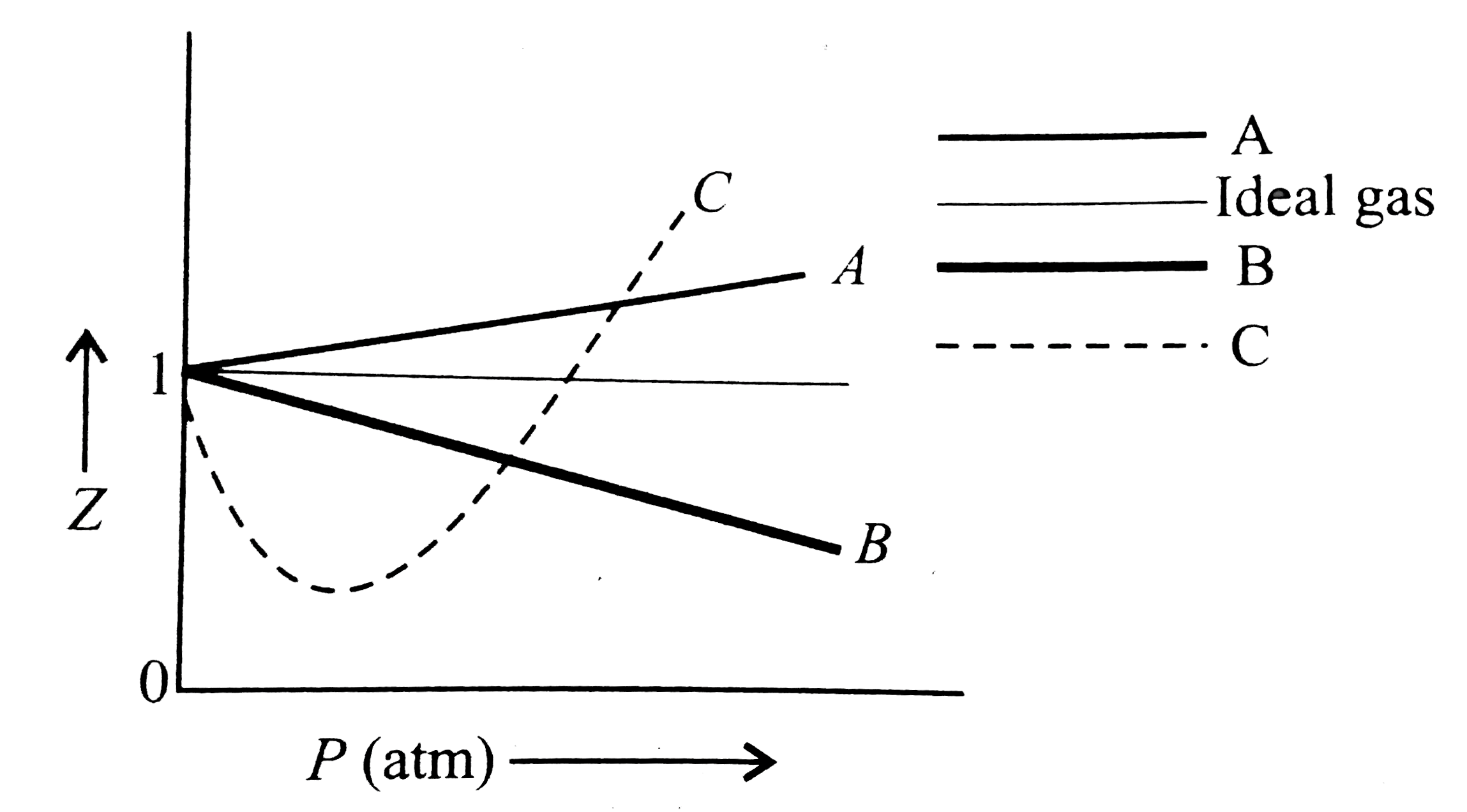
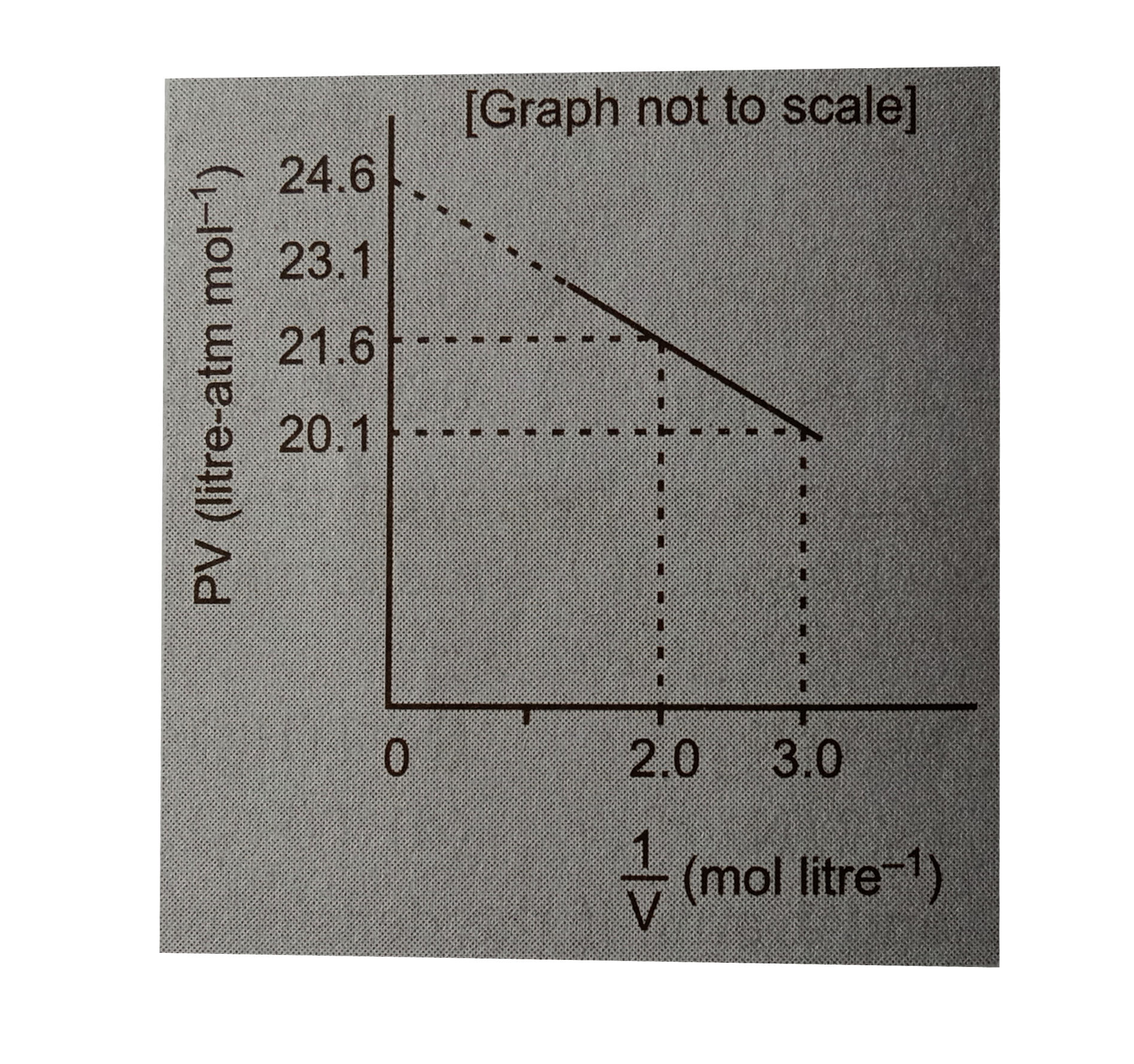 .
.